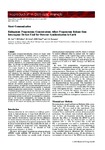Use este identificador para citar ou linkar para este item:
http://www.alice.cnptia.embrapa.br/alice/handle/doc/1035687Registro completo de metadados
| Campo DC | Valor | Idioma |
|---|---|---|
| dc.contributor.author | NERI, H. L. | pt_BR |
| dc.contributor.author | PALHAO, M. P. | pt_BR |
| dc.contributor.author | COSTA, D. S. | pt_BR |
| dc.contributor.author | VIANA, J. H. M. | pt_BR |
| dc.contributor.author | FERNANDES, C. A. C. | pt_BR |
| dc.date.accessioned | 2016-02-01T11:11:11Z | pt_BR |
| dc.date.available | 2016-02-01T11:11:11Z | pt_BR |
| dc.date.created | 2016-02-01 | pt_BR |
| dc.date.issued | 2015 | pt_BR |
| dc.identifier.citation | Reproduction in Domestic Animals, v. 50, n. 4, p. 692-695, 2015. | pt_BR |
| dc.identifier.uri | http://www.alice.cnptia.embrapa.br/alice/handle/doc/1035687 | pt_BR |
| dc.description | Intravaginal progesterone-releasing devices are largely used both as contraceptives in humans and as a component of oestrous synchronization protocols in cattle. To reduce costs in large-scale timed artificial insemination, the reuse of these releasing devices is common. Passive hormone diffusion, however, depends on the concentration gradient, which could affect the amount of residual progesterone present in these devices after a first use. To evaluate the effect of the presence of a corpus luteum in the release of progesterone from intravaginal devices, three synchronization protocols were designed to simulate the effects of inserting the device in the early dioestrus, late dioestrus or anoestrus. Holstein-Zebu cross-bred heifers were randomly allocated into one of these three treatments, and a series of blood samples was taken to evaluate the plasma progesterone concentrations. After 8 days, the intravaginal devices were removed and underwent a previously validated alcoholic extraction technique to measure the residual progesterone. Non-used devices were used as controls. As expected, the simultaneous presence of the intravaginal device and a corpus luteum resulted in increased plasma progesterone concentrations. Conversely, the amount of residual progesterone in the devices after use was inversely proportional to the plasma progesterone concentration. These results demonstrate that the release rate of progesterone from intravaginal devices is affected by the endogenous concentration of this hormone; consequently, the strategy for reuse should account for the category and expected luteal cyclic activity of the animals undergoing synchronization protocols. | eng |
| dc.language.iso | eng | eng |
| dc.rights | openAccess | eng |
| dc.subject | Oestrous synchronization | pt_BR |
| dc.title | Endogenous progesterone concentrations affect progesterone release from intravaginal devices used for oestrous synchronization in cattle. | pt_BR |
| dc.type | Artigo de periódico | pt_BR |
| dc.date.updated | 2016-04-15T11:11:11Z | pt_BR |
| dc.subject.nalthesaurus | animal reproduction | pt_BR |
| dc.subject.nalthesaurus | progesterone | pt_BR |
| riaa.ainfo.id | 1035687 | pt_BR |
| riaa.ainfo.lastupdate | 2016-04-15 | pt_BR |
| dc.contributor.institution | H. L. Neri, UNIFENAS, MG; Hertape-Calier, Juatuba, MG; M. P. Palhao, UNIFENAS, MG; D. S. Costa, Universidade Federal do Mato Grosso do Sul; JOAO HENRIQUE MOREIRA VIANA, CNPGL; C. A. C. Fernandes, UNIFENAS. | pt_BR |
| Aparece nas coleções: | Artigo em periódico indexado (CNPGL)  | |
Arquivos associados a este item:
| Arquivo | Descrição | Tamanho | Formato | |
|---|---|---|---|---|
| Cnpgl2015RepDomAnEndogenous.pdf | 264.82 kB | Adobe PDF |  Visualizar/Abrir |









